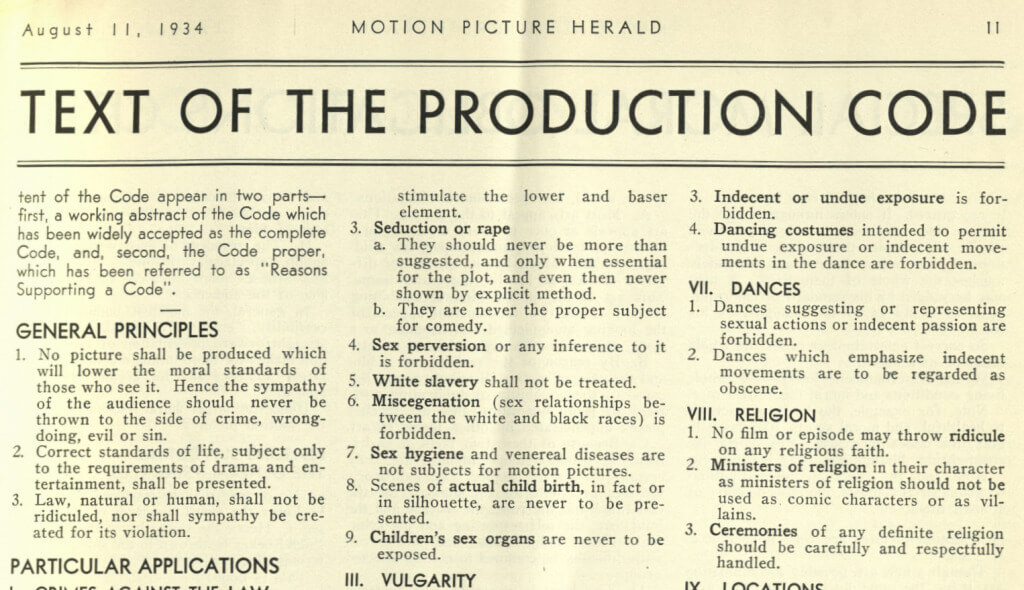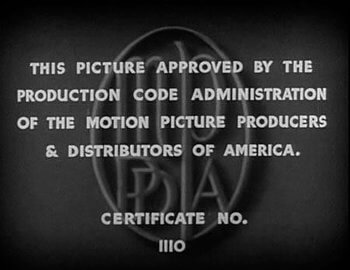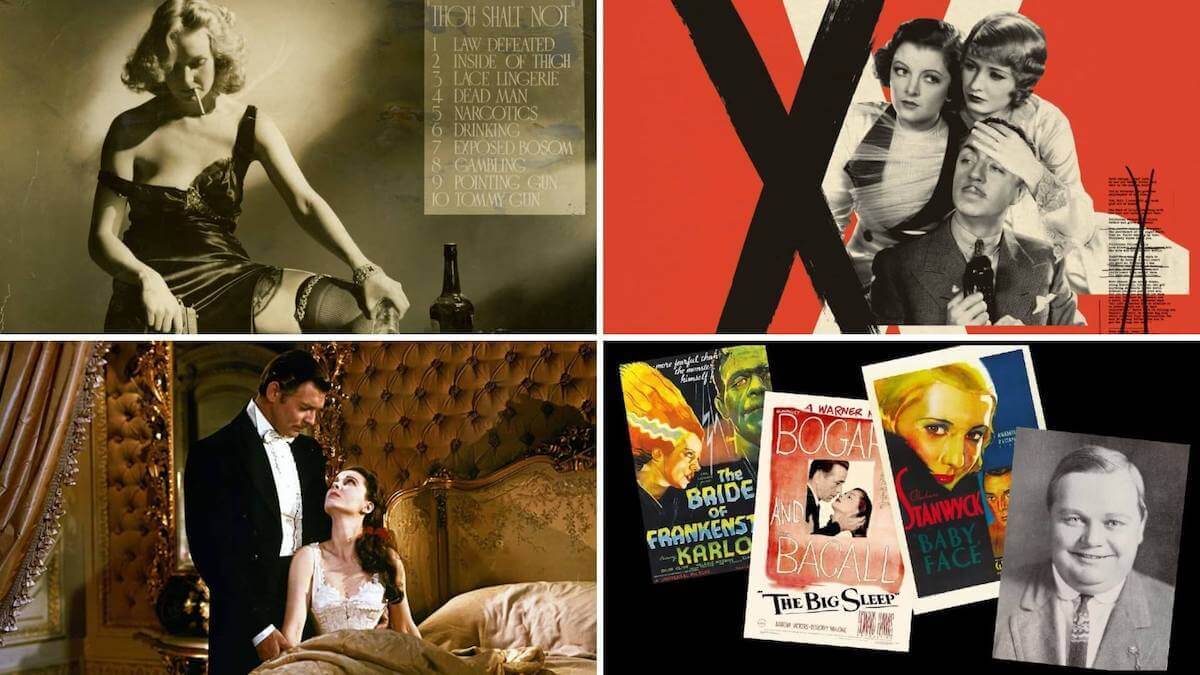Have you ever watched an old black and white movie, maybe starring Humphrey Bogart or Katherine Hepburn, and thought some of it was a bit tame? Even when the movies are great, they seem to play it safe? Most of this is a direct result of what is popularly known as the Hays Code, which most movies had to abide by for a period of time. But what is the Hays Code, and is there more to it than just a few rules and limits?
What is the Hays Code
Origins of the Hays Code
The Hays Code is not as simple as a few rules that filmmakers had to follow, though it was definitely that, too. But before digging into its origins and historical context, let’s provide a definition.
HAYS CODE DEFINITION
What is the Hays Code?
The Hays Code is a set of rules and guidelines that Hollywood films were made to follow between the early 1930s and late 1960s. Officially named the Motion Picture Production Code, these were a set of moral guidelines and rules that were meant to make Hollywood pictures “presentable” and “safe” for the public at large, which meant not covering or featuring certain controversial topics, themes, or actions.
Hays Code examples include:
- Keeping Catholic and family values
- No sexually explicit content
- Good guys always win, bad guys always lose
- Nothing that promotes “bad values” or “perversion”
- No swearing and saying offensive things
The Hays Code got its popular nickname from Will H. Hays, a Presbyterian elder who was made president of the Motion Picture Producers and Distributors of America (MPPDA), who set up the Motion Picture Production Code and its guidelines.
Hays was brought to Hollywood because their image was not too pretty in the 1920s. Serious scandals in Hollywood and concerns from people across the nation was making the pre Hays Code movies look bad. States were setting up their own censorship guidelines, and Hollywood was very worried about the US government getting involved.
The video below covers not just the Hays Production Code but also censorship in general in Hollywood.
What is the Hays Code • Hollywood Censorship
So while Pre-Code Hollywood was making pre Hays Code movies that covered sex and violence, they were also thinking it was best to self-censor so that they could hopefully prevent anyone else from intervening. In this way, they would have a nationwide rulebook that would cover all their bases and, hopefully, offend no one (especially the Hays office).
By the way, in case you were wondering where the First Amendment was during all this, it had been decided in a 1915 court case that free speech did not cover motion pictures because they were seen solely as a business and not an art form.
Hays Office Movies
The Hays Code in action
The MPPDA had set up its rules of “Don’ts” and “Be Carefuls” in 1927, a set of guidelines that, among other things, said movies could not include “Pointed profanity,” “Miscegenation” (that’s relations between races), “Ridicule of the clergy,” and “Willful offense to any nation, race or creed.”
These “Don’ts” were then supplemented by the “Be Carefuls” that included “The use of firearms,” “Sympathy for criminals,” “Man and woman in bed together,” “The use of drugs,” and “Excessive or lustful kissing.” These “rules” were the basis for what would officially be the Hays Code a few years later.

Hays Code 1934
1929 saw Catholic layman Martin Quigley and Jesuit priest Father Daniel A. Lord got involved to revise and solidify the Code, along with seeking the approval of the studios a year later. Studios were not exactly thrilled about the Code, but better to self-censor themselves than have the government step in.
You can get a better idea of how the Catholic church effectively helped put its values to the forefront with the Motion Picture Production Code by watching the video below.
What is the Hays Code • Cinema and Catholicism
All of this didn’t stop trade magazines and filmmakers from balking at the Code, and movies full of sex and violence kept being made. After all, these enforcers couldn't possibly read every script or watch every movie and expect the filmmakers to abide by their silly rules.
Enter the Production Code Administration (PCA), created in 1934 and headed by Joseph I. Breen (another Catholic layman), who helped make it a requirement that all movies produced in Hollywood be given a stamp of approval by the PCA prior to release.
From then on out, studios and filmmakers had to abide by the rules, especially since the PCA now made it more of a requirement than ever before.

Hays Code 1934 • MPPDA Seal of Approval
For the next couple decades, the Hays Production Code was a way of life for Hollywood (but not for movies made outside of Hollywood, which weren’t getting widely distributed anyway). Thankfully the Hollywood Production Code didn’t stop filmmakers from making great movies, as plenty of classics came out between 1934 and the 1960s.
In some cases, like Gone with the Wind (1939) and The Outlaw (1943), filmmakers challenged the PCA to retain certain elements of their movies.
Martin Scorsese’s Howard Hughes biography, The Aviator (2004), actually covers the situation involving The Outlaw, since Hughes was the movie’s writer-director. You can see in the clip below the film’s dramatization of how Hughes fought to convince for approval.
What is the Hays Code • Hughes vs Breen
In other cases, like Casablanca (1942), it is said that the Hollywood Production Code actually helped make the movie better. Instead of Rick (Humphrey Bogart) and Ilsa (Ingrid Bergman) ending up together (which would be adulterous), he sends her away, resulting in the classic scene below.
What is the Hays Code • Casablanca
The PCA also did not allow anti-Nazi films to proliferate at first, since that would go against the whole “don’t make other countries look bad” rule. The irony, of course, was that, when it became clear how terrible the Nazis were, the US government actually commissioned Hollywood to make anti-Nazi propaganda and war films.
Related Posts
Hays Office Ends
The Hays Production Code demise
As you may have guessed, the Motion Picture Production Code was not built to last. The 1950s brought the first signs of its demise in the form of court cases and new foreign movies that were not bossed around by the PCA.
1948 saw the Supreme Court disband movie studio ownership of movie theaters, which then allowed foreign films of all types to be screened in the USA. 1952 also saw the Supreme Court overruling its previous decision regarding movies as a business, permitting them to now be seen as art by granting them First Amendment rights.
Some of these foreign films included classics from the Italian Neorealism movement, while the later French New Wave would also make its presence known in North America. These films featured more risque subject matter and helped give Hollywood peace of mind about government intervention, thus weakening the Film Production Code.
The Hollywood Production Code itself got revised in the mid-’50s, allowing films such as Anatomy of a Murder (1959) and Psycho (1960) to be released mostly as the directors intended. Anatomy’s director, Otto Preminger, in particular was fond of covering subject matter the Code would have prohibited prior to the 1950s, such as drug addiction in The Man with the Golden Arm (1955), which was critically acclaimed and nominated for three Oscars.
The Man with the Golden Arm directed by Otto Preminger
If any movie proved that the Hays Code was no longer relevant or something to fear, it was Billy Wilder’s Some Like It Hot (1959). Featuring men in drag, murder, booze, and Marilyn Monroe, the film was actually not approved by the PCA. But of course that didn’t matter because the film went on to be a huge success and is seen as a comedic classic today.
As the 1960s rolled on, the old Hays Code was basically a joke that no one followed. Times were changing, and what was once seen as offensive in the ‘30s was a lot less problematic in the ‘60s.
Movies like The Pawnbroker (1964) dealt with the Holocaust and featured not only women’s bare breasts but a homosexual character; it got approved by the PCA with only minimal edits required.
The Film Production Code was on its last legs by the time Michelangelo Antonioni’s Blow-Up (1966) came out, a film that also did not get PCA approval, but the MGM released it anyway. An American film by a famed Italian director, Blow-Up was more frank in its sexual topics, which in itself came with controversy.
An analysis of Blow-Up
In 1968, the Motion Picture Production Code was abandoned for good, and by that time, the MPPDA was renamed the MPAA (Motion Picture Association of America), who set up the ratings system that we now have today. That same ratings system allowed for the burgeoning New Hollywood scene to be as varied and daring as it was.
Times continue to change, but with the support of filmmakers, law makers, and the ‘60s counter culture movement, movies were able to finally free themselves from a system that was outdated from its inception.
UP NEXT
The New Hollywood Revolution
Now that we have gone over the Hays Code and what it was all about, why not see what came after its retirement? The end of the Hays Code coincided with the creation of the New Hollywood era, which included giants like Steven Spielberg, George Lucas, Francis Ford Coppola, and Martin Scorsese making films unlike anyone had ever seen before.
Up Next: New Hollywood →
Showcase your vision with elegant shot lists and storyboards.
Create robust and customizable shot lists. Upload images to make storyboards and slideshows.
